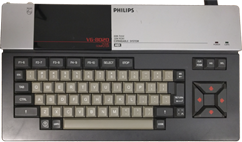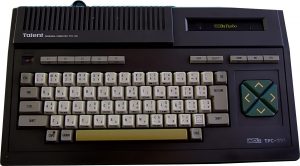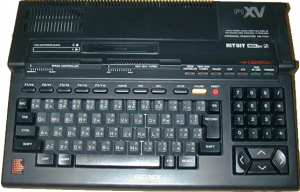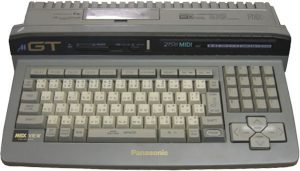MSX computers in the beginning of the domestic microcomputing
Sergio Martín Sesma
The modern microcomputing has its beginning many years ago. One of the fathers of what it is known today as computing is the MSX.
In the 80s, Kazuhiko Nishi proposed MSX as an intention of creating a unique standard for all the industry of personal computers. Inspired by the success of the VHS as a way of recording video, a lot of Japanese manufacturers promote the MSX computers. Any piece of the hardware or software had the MSX logo on it. It was compatible with the MSX products of other manufacturers.
 |
|
The origin of the name MSX is uncertain, although some people thought it came from “MicroSoft extended basic”. In April 1997, Business Japan published an article named “the samurai of the electronic thoughts”. In it, it is told that the acronym was initially MNX from the names Matsushita, Nishi and the X referred to the unlimited power.
That name was already registered so Nishi changes the N for the S of Sony (first company to give it a licence). He said to every company who was going to sell the computer that the X stood for their company, like they told Bill Gates that the name was because of MicroSoft. Finally, Nishi has recently said that MSX stands for Machines with Software Exchangeability.
Generation MSX
MSX computers had three generations of microcomputers of 8 bits (MSX1, MSX2 and MSX2+) and only one of 16 bits (MSX TurboR).
MSX1
The first MSX to reach the public was Sony HB-10 in 1983. In Japan was built in red and white and it was made black to sell it abroad.
The computers built under the MSX norm, only called MSX, were known like MSX first generation or MSX-1 to. They were made by Sony, Philips, Panasonic, Canon, Goldstar, Toshiba, Casio, Spectravideo, Pionner, Sanyo, JVC, Daewo, Mitsubishi, National, Hitachi, Sharp, Yamaha, Fujitsu, Sharp and Samsung among others. Some companies like Sony or Philips launched around ten models.
 |
|
MSX2
The success of MSX2 was similar to the first generation MSX. The manufacturers did not only carry on with the standard but they included different characteristics which made each computer useful for different users. There were basic MSX2 but also a professional type to edit videos, with configurations for musicians and to operate as communication terminals.
At the end of the 90s, due to the appearance of the local televisions, it was usual to find MSX2 used for operations in videos or generating graphic effects. Nevertheless, in 1988, its distribution to Europe stopped and the standard was only made in Japan, Korea and some countries in Asia or South America.
 |
|
MSX2+
In 1988, where MSX1 and MSX2 were not sold in Europe, in Japan and Korea appeared the new generation: MSX2+. Only four manufacturers were involved in this evolution: Panasonic, Sony, Sanyo y Daewo. In spite of Philips’ initial intentions to make the MSX2+, it quit the project because at that time they sell computers compatible with PC.
ASCII, which was the company promoter of the standard, started at the end of the 80s, the development of the future MSX3. Its launching was planned for 1990. Instead, all the manufacturers except Panasonic, quit the developments of the MSX so the company launched the last two models under the name MSX TurboR.
 |
|
MSX TurboR
The MSX TurboR was a computer with highly technical performances. It included a 16 processor (compatible with the Z80 of the previous MSX). It was the last generation of the standard MSX. Its price was a drawback. For a bit more, you could afford more advanced microcomputers. Besides, this computer had some compatibility problems with a lot of games and programs before MSX and a lot of the peripherals of the late MSX were useless.
All this caused that, like MSX2+, the computer was only distributed in Japan. In fact, the computer only has a Japanese version of the BIOS and its keyboard does not support international characters. Some units were sold in Europe and Brazil through importation although some prices were very high.
 |
|
Video games in MSX
The standard MSX has some fabulous games which nowadays we can enjoy. We can find also video games which were the foundation of the most known and successful video games nowadays:
- Ys II: Ancient Ys vanished: it is similar to The Legend of Zelda saga but this games focuses in the direct action with puzzles and ARPG (action role playing game).
- The Goonies: this video games was an adaptation of the adventure movie for children more successful in the 80s.
- Knightmare: in this game, Popolon, the protagonist knight of The Maze of Gallious, is presented for the first time. It is a vertical scroll game with a fantasy theme.
- Metal Gear: this was the first game of the Hideo Kojima’s saga. One of the most long-standing and recognized in the world of video games. Solid Snake, Big Boss or Gray Fox are some of the awesome characters who present this masterpiece in which the goal was not to shoot and attract attention but to go unnoticed.
- Metal Gear 2. Solid Snake: this is the second part of the saga Metal Gear and probably the best title of all the MSX catalogue. In this game new mechanics to go unnoticed were added. Also, more intelligent enemies or the introduction of a countdown when the alarm is set when you are detected.
- Yie Ar Kung-Fu: this was the one that set the foundation to the modern fight games. It had an impact on games like Street Fighter.
- Vampire Killer: this games was the first game in the Castlevania saga launched in Europe before the NES’ Castlevania.
Next, you could see a video with a Top 10 MSX games from Konami. It was precisely with MSX computers that Konami got a name, getting to be one of the main firms in the video games’ development.
Resources on the internet
On the Internet we can find heaps of websites with news, forums, video games, pictures, etc. Among the website we highlighted two of them, one in English and the other one in Spanish.
The first one is the MSX official website. It is called MSX Resource Center and it is a very complete page where you can find all the information about the standard MSX. You can find news, download programs and video games, articles and there is a forum where you can share your thought with the rest of MSX users.
On the other hand, we have the AAMSX. It is a Spanish website that has numerous news. They have annual meetings so the standard MSX user can share or learn new information with the rest of the users.
Also, it is remarkable the closeness of the owners of the webpage, especially Toni, who has no problems in answering questions or doubts about the standard Nishi.
Publicity
Besides heaps of books in different languages about the MSX, from basic user to advanced programmer, it appeared in a lot of countries, regular publications dedicated to the standard, especially in Japan, the Netherlands or Spain. Among the pages in the magazines, you could find a lot of advertisements about MSX products. Also, you could find tutorials on how to program in MSX Basic for the beginners in the Nishi standard computer.
The magazines had a big reserved spot for programs created by the readers, giving weekly awards to the best program by competitions in which the users could show who was the best programming in MSX Basic.
In Spain, MSX Club, MSX Extra, MSX Magazine or Input MSX were very popular.
MSX computers were advertised by their own magazines, TV or the newspaper. With paper advertisements you could see the image of the computer with a description which was the reason for you to buy the product. Also, they were other products (not necessarily MSX) like cartridge, controllers to play, video games, floppy disks and even printers.
Like we said, MSX computers were born with the intention to introduce itself in the market of personal computers. For that, they invested a lot in advertisements on TV. In some ads you could see broken, stressed families but when they got the MSX computer they came together to enjoy their new computer.
Lastly, you could see one of the funniest and most curious advertisement to promote the standard. It is a Japanese advertisement published by Zemmix MSX. The characters form part of a video game and they appear in a car, wearing a spacesuit and silver helmets.
